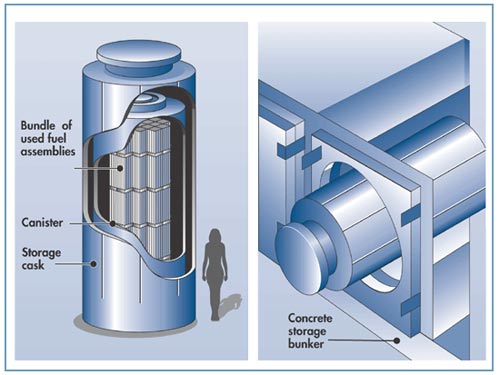Back to the drawing board after Yucca Mountain

Dry interim storage in the United States
Casks generally consist of a sealed metal container containing spent fuel assemblies, and are in turn over-packed with an outer metal or concrete shell. Casks may either be laid horizontally or stand vertically on a concrete base. The NRC requires fuel assemblies to have been cooled for a number of years before being placed in dry storage.
© Nuclear Regulatory Commission (NRC)
WIPP, the first deep geological repository to begin operating, in 1999, is a special case. It is intended for low- and intermediate-level long-lived military waste.
The chosen option for low- and intermediate-level short-lived waste, on the other hand, is a near-surface repository. Each State hosting nuclear installations is required to build suitable low-level radioactive waste disposal facilities, either independently or jointly with one or more neighbouring States.
Concerning the most radioactive materials, the United States ceased reprocessing its civilian spent fuel in 1992, under the Ford-Carter doctrine. This material is now stored onsite at power plants and national laboratories. The 1982 Nuclear Waste Policy Act entrusted the Department of Energy (DOE) with the task of managing spent fuel from nuclear reactors and building a geological repository fit for the purpose.
The US Congress approved the Yucca Mountain site in a compact volcanic ash formation (known as tuff) in the Nevada desert in 1987. In 2002, then-President Bush approved the decision to build this repository, which would be used to dispose of civilian spent fuel as well as military high-level waste. In 2002, Congress confirmed the choice of Yucca Mountain as the site for a repository that would primarily be used to dispose of spent fuel.
An application for a construction license had been submitted to the Nuclear Regulatory Commission (NRC) and was being processed. The first stages of commissioning the facility were scheduled for 2010-2012, subject to clearing the final obstacles. However, this outcome was not a foregone conclusion, owing to certain criticisms levelled at the project, and indeed, everything did not go according to plan…
The Yucca Mountain underground repository project ran up against a number of difficulties. The corrosive nature of tuff required costly conditioning. The rock would be fractured and is located under the water table. Furthermore, the site’s capacity would rapidly be saturated, due to the volume of civilian spent fuel and the heat released by such materials, requiring them to be spaced out in the repository.
Since the Yucca Mountain project was abandoned, the Department of Energy (DOE) has been seeking alternative waste disposal solutions. The United States do not expect to choose a new repository site within the next decade at least. A new commission, the Blue Ribbon Commission on America’s Nuclear Future, was set up in 2010. The Department of Energy (DOE) has plans to open centralised interim storage facilities with effect from 2021, and to open a geological repository in 2048.
Has the project been permanently abandoned? In August 2013, the American courts instructed the US nuclear safety authority, NRC, to continue processing the operating license application. Funding allocated by Congress but not by the executive Administration might enable the project to be restarted.
The processing and recycling option is once again a subject of debate within the US nuclear research community. Prior to the Fukushima accident, a nuclear revival leading to the construction of new power plants appeared likely. What does the future hold? With the prospect of more modern reactors, and looking ahead, fourth-generation reactors, the USA appeared ready to abandon its opposition to reprocessing, and by extension, reverse its decision to bury plutonium from reactors together with waste.
Interim storage in pools and dry storage
Spent fuel from nuclear power plants is stored for an initial period in nearby pools. However, these pools fill up; when they become saturated, spent fuel is placed in dry storage. Fuel assemblies are removed from the pool and cooled by natural air flows. Such cooling is possible because the amount of heat released decreases sufficiently during initial storage. The heat released by a storage cask containing 24 fuel assemblies is considerably less than that produced by the central heating system in a family home.
Dry interim storage of spent fuel is considered to be safe and environmentally friendly. Over the past 20 years, there have been no releases of radioactivity or contamination affecting the general public, and no known sabotage attempts. Currently, dry interim storage at production sites is practiced at 25 operating reactors, seven decommissioned reactors and two interim storage sites at the national laboratory in Idaho.
Other articles on the subject « Geological disposal »
Waste duration
Nuclear spent fuel and vitrified waste: what legacy? « Much of this nuclear waste will remain haz[...]
CIGEO project
CIGEO – Overview of a planned repository The efforts made by engineers to ensure that highl[...]
Clay medium
The Callovo-Oxfordian argilite The geological stratum or ‘host rock’ that will[...]
Bure underground laboratory
A research laboratory for a disposal facility site Before high-level radioactive waste is buried [...]
Results on deep clay disposal
What we know about the disposal facility site In its final report in 2006 the French National Ass[...]
High-level waste repositories
Disposal of high-level waste packages The high-level waste packages requiring disposal will proba[...]
ILW-LL waste repositories
Filling an intermediate-level waste disposal cell Intermediate-level (ILW-LL) waste releases litt[...]
WIPP Project
The world’s first deep geological repository The United States is the first country in the [...]
Waste disposal Sweden
Sweden and Finland – Exemplary waste management Sweden probably features among the E[...]
Other countries
Shared challenges and similar solutions In most countries with nuclear industries, solutions for [...]